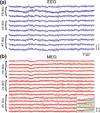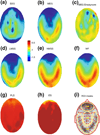Comparative power spectral analysis of simultaneous electroencephalographic and magnetoencephalographic recordings in humans suggests non-resistive extracellular media : EEG and MEG power spectra
- PMID: 20556640
- PMCID: PMC4451436
- DOI: 10.1007/s10827-010-0252-5
Comparative power spectral analysis of simultaneous electroencephalographic and magnetoencephalographic recordings in humans suggests non-resistive extracellular media : EEG and MEG power spectra
Abstract
The resistive or non-resistive nature of the extracellular space in the brain is still debated, and is an important issue for correctly modeling extracellular potentials. Here, we first show theoretically that if the medium is resistive, the frequency scaling should be the same for electroencephalogram (EEG) and magnetoencephalogram (MEG) signals at low frequencies (<10 Hz). To test this prediction, we analyzed the spectrum of simultaneous EEG and MEG measurements in four human subjects. The frequency scaling of EEG displays coherent variations across the brain, in general between 1/f and 1/f (2). In a given region, although the variability of the frequency scaling exponent was higher for MEG compared to EEG, both signals consistently scale with a different exponent. In some cases, the scaling was similar, but only when the signal-to-noise ratio of the MEG was low. Several methods of noise correction for environmental and instrumental noise were tested, and they all increased the difference between EEG and MEG scaling. In conclusion, there is a significant difference in frequency scaling between EEG and MEG, which can be explained if the extracellular medium (including other layers such as dura matter and skull) is globally non-resistive.
Figures





References
-
- Abd El-Fattah MA, Dessouky MI, Diab SM, Abd El-samie FE. Speech enhancement using an adaptive Wiener filtering approach. Progress in Electromagnetics Research. 2008;4:167–184.
-
- Abdi H. Partial least square regression, projection on latent structure regression, PLS-regression. Computational Statistics. 2010;2:97–106.
Grants and funding
LinkOut - more resources
Full Text Sources

